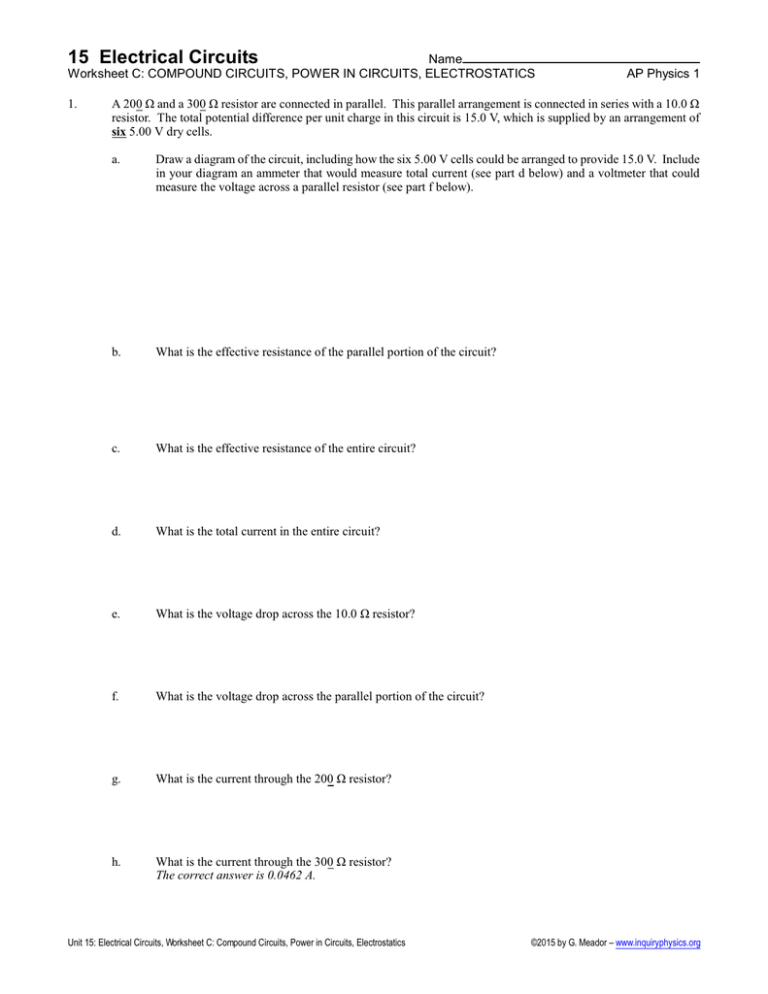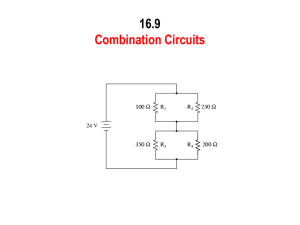AP Physics version of circuits
advertisement

15 Electrical Circuits Name Worksheet C: COMPOUND CIRCUITS, POWER IN CIRCUITS, ELECTROSTATICS 1. AP Physics 1 A 200 Ù and a 300 Ù resistor are connected in parallel. This parallel arrangement is connected in series with a 10.0 Ù resistor. The total potential difference per unit charge in this circuit is 15.0 V, which is supplied by an arrangement of six 5.00 V dry cells. a. Draw a diagram of the circuit, including how the six 5.00 V cells could be arranged to provide 15.0 V. Include in your diagram an ammeter that would measure total current (see part d below) and a voltmeter that could measure the voltage across a parallel resistor (see part f below). b. What is the effective resistance of the parallel portion of the circuit? c. What is the effective resistance of the entire circuit? d. What is the total current in the entire circuit? e. What is the voltage drop across the 10.0 Ù resistor? f. What is the voltage drop across the parallel portion of the circuit? g. What is the current through the 200 Ù resistor? h. What is the current through the 300 Ù resistor? The correct answer is 0.0462 A. Unit 15: Electrical Circuits, Worksheet C: Compound Circuits, Power in Circuits, Electrostatics ©2015 by G. Meador – www.inquiryphysics.org AP Physics 15 WS C 2. Fill out the table for the circuit diagramed at right. use proper sig figs Circuit Position Current (A) Resistance (Ù) 10.0 2 20.0 3 30.0 6.00 Fill out the table for the circuit diagramed at right. use proper sig figs Circuit Position Voltage (V) Current (A) Resistance (Ù) 1 10.0 2 20.0 3 30.0 Total 4. Voltage (V) 1 Total 3. Page 2 of 5 6.00 Fill out the table for the circuit diagramed at right. use proper sig figs Circuit Position Voltage (V) Current (A) Resistance (Ù) 1 10.0 2 20.0 3 30.0 Total 6.00 5. If the cells are identical, which circuit would draw the most current from the cell? 6. If the resistors are identical, which circuit would have the lowest overall change in electrical potential energy per unit charge? Unit 15: Electrical Circuits, Worksheet C: Compound Circuits, Power in Circuits, Electrostatics ©2015 by G. Meador – www.inquiryphysics.org AP Physics 15 WS C Page 3 of 5 KIRCHOFF’S LAWS: 7. Use the diagram of the compound circuit to answer the following questions. You must apply Kirchoff’s Laws, showing all relevant equations and calculations in the spaces below, using proper signs. a) Draw labeled current arrows on the diagram at right for the currents I1, I2, and I3 at the upper node. b) Using the node rule, write in the space below an appropriate expression for the relationship among I1, I2, and I3. c) Draw two labeled Kirchoff loops on the diagram at right. d) Using the loop rule and appropriate signs, write in the space below an expression for each loop in terms of the appropriate labeled currents and the voltage and/or resistance values (with units) shown in the diagram. e) Simultaneously solve the equations from parts b) and d) and solve for the value of the current through each resistor and the voltage across each resistor, showing your work in the space below. Unit 15: Electrical Circuits, Worksheet C: Compound Circuits, Power in Circuits, Electrostatics ©2015 by G. Meador – www.inquiryphysics.org AP Physics 15 WS C Page 4 of 5 POWER IN CIRCUITS: 8. Fluffy’s shock collar (she meows too much) delivers a current of 0.0600 A and runs on a 9.00 V battery. a) What is the power of the collar circuit in watts? b) Over a three month period the collar is in operation for a total of 600 seconds. How many joules of electrical energy were consumed during that period of time? show the equation c) A typical 9.00 V battery might cost $2.40 and provide 19,250 J of energy. What is the cost of running the shock collar as described in parts a and b? ELECTROSTATICS: COULOMB'S LAW Two point charges q1 and q2 separated a distance d apart will attract or repel each other with a force given by the formula below, called Coulomb's law. The constant k is taken to be 9.00×109 Nm2/C2. 9. Two identical tiny metal balls carry charges of +3.00 nanocoulombs and !12.0 nanocoulombs. Their centers are 3.00 cm apart. a) Compute the amount of force between them and specify its effect (state if it is attractive or repulsive). b) The balls are now touched together and then separated to 3.00 cm. What is the new charge on each ball? c) Calculate the magnitude and also specify the effect of the forces on each ball, given what occurred in part b. Unit 15: Electrical Circuits, Worksheet C: Compound Circuits, Power in Circuits, Electrostatics ©2015 by G. Meador – www.inquiryphysics.org AP Physics 15 WS C Page 5 of 5 In the space to the left, write the letter of the answer to the question. 10. Which atom pictured below is electrically neutral? 11. Two negatively charged rods are brought near a positively charged ball. What is the direction of the net force on the ball due to the rods? 12. A negatively charged rod is brought near the right hand side of two neutral metal spheres that are touching one another while insulated from the ground. The spheres are then separated and the rod is taken away. Which pair of spheres shows the correct signs of each sphere’s net charge? 13. Which of the following is NOT a possible net charge of an ion (an electrically charged atom)? D) – 3.2 × 10-19 C C) – 2.4 × 10-19 C B) – 1.6 × 10-19 C A) + 1.6 × 10-19 C 14. Two objects exert an electric force of size F on each other. If the charge on each object is doubled and they are moved three times closer together, the electric force will now be... A) 36 F B) 18 F C) 12 F D) 3/4 F 15. Two objects a certain distance apart each have a charge of positive four microcoulombs (+4 × 10-6 C or +4 ìC) which creates a repulsive force of size F on each object. If +2 ìC of charge is transferred from one object to the other, the repulsive force will now be... A) 4 F B) 2 F C) 3/4 F D) ½ F Unit 15: Electrical Circuits, Worksheet C: Compound Circuits, Power in Circuits, Electrostatics ©2015 by G. Meador – www.inquiryphysics.org




